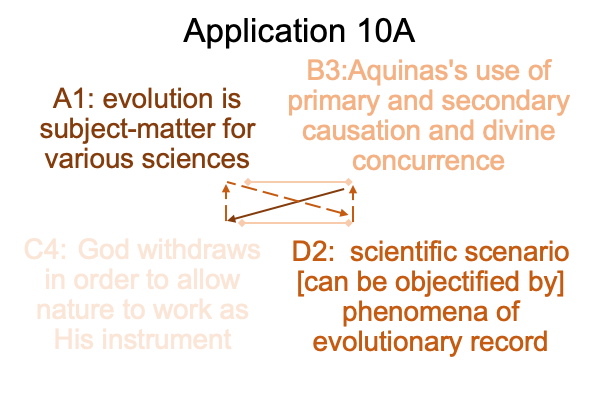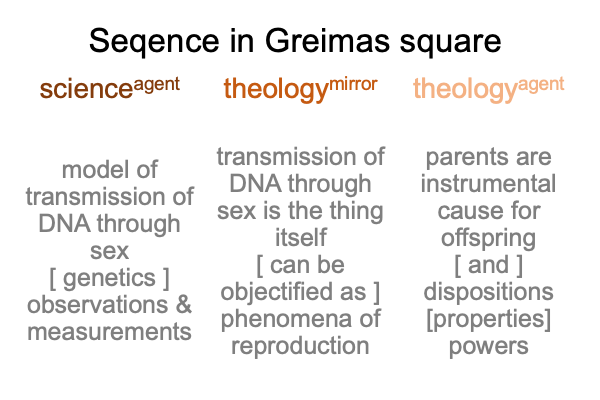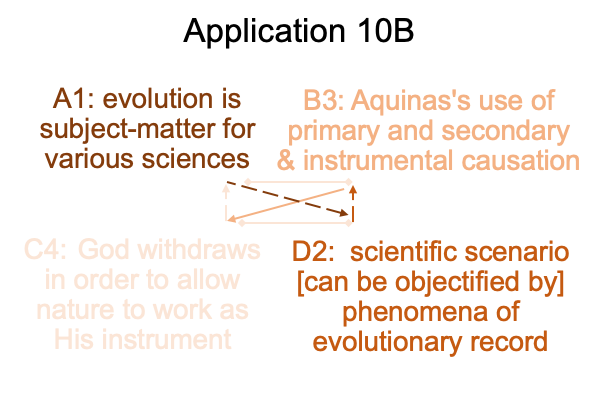0811 The problem (or is it the bill?) arrives in the next chapter, the seventh, titled Concurrence of Divine and Created Causes in Evolutionary Transitions.
Here is a problem for evolutionary creation (as opposed to theistic evolution).
If a theologyagent (B) uses Aquinas’s distinction between primary and secondary causation to account for the “mechanics” of evolutionary transitions, then the theological account becomes fuzzy, due to a lack of precision in defining secondary causes.
On top of that, the notion of the union of primary and secondary causes in evolutionary transitions, called “divine concurrence” (B), ends up confirming the scientist’s projection of his model into the mirror of theology (D), in so far as God “withdraws” in the face of scientific mathematical and mechanical propositions (C).
Of course, the reflection is reasonable.
Why would God break the rules that God created?
0812 Here is a picture of the resulting Greimas square of Tabaczek’s mirror.

0813 Tabaczek offers a refinement to one exercise in evolutionary creation, in an effort to translate it into an exercise in theistic evolution.
Tabaczek focuses on the slow transition of one species to (say) two species over time, due to (say) a geographical separation of the species induced by a geological barrier. The two species genetically drift apart due to random walks of DNA modifications. This isolation model relies on the constant production of variability with offspring, with very little natural selection.
The isolation model is one of the favorite explanations for speciation by geneticists, because it relies only on the phenotype side of the intersection for species. Forget those natural historians with their excursions into nature. The genetics lab is the place to be.
0814 By now, the reader of this examination is familiar with the use of the Greimas square for elaborating the optics of Tabaczek’s mirror.
It is not perfect. But, it is certainly suggestive.
Here are the first three steps to evolutionary creationism.

0815 For example, a geneticist models the speciation of isolated populations with simulations of DNA-sequence drift due to random errors induced by extra-terrestrial gamma rays plus random assortment of chromosomes in sexual reproduction. Actually, one does not really need the gamma rays, but I thought I would throw that in because gamma rays increase modification in the slogan “descent with modification”.
0816 Then, the scientist (A1) looks in the mirror of theology (D2) and declares, “My model is really better than the noumenon of speciation due to geological barriers because it is way more scientific than ‘Hey look, the butterflies on this side of the mountain are different than the ones on the other side.’.”

The evolutionary creationist (B3) then takes what he sees in the mirror of theology (D2) and makes a distinction between transcendent and immanent orders of causation. The transcendent order associates to primary causation. The immanent order associates to instrumental and secondary causations. Instrumental causation goes with the scientific overlay of the noumenon. Secondary causation goes with the dispositions [properties] powers of the parents and offspring… and well… all the phenomena that go with a single act of “descent with modification”.
0817 Whew!
Was that the dessert?
